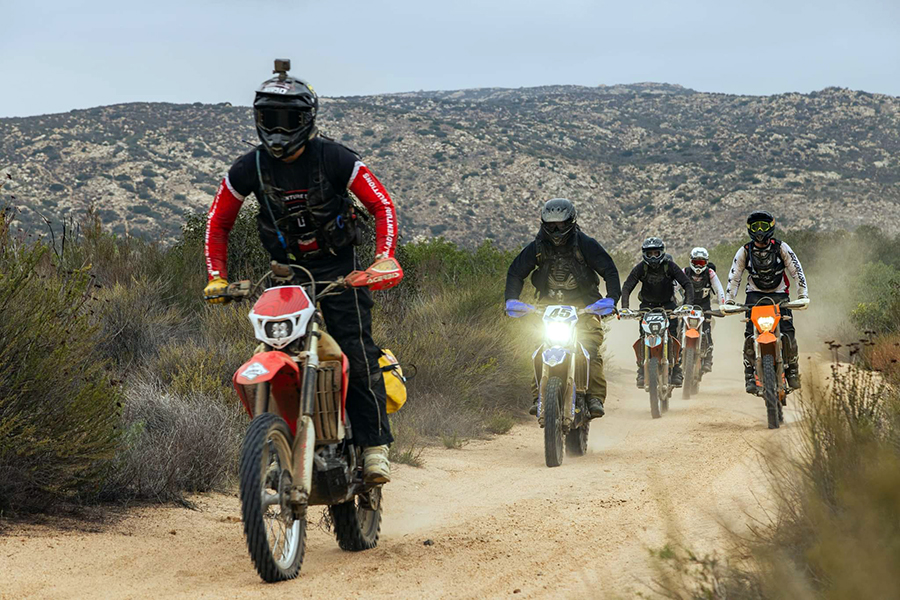How to Prepare Your Bike for Baja’s Rugged Terrain


1. Essential Maintenance Checks
Before heading out to Baja, it’s crucial to perform thorough maintenance on your bike. Start with a comprehensive inspection to ensure all components are in excellent working order.
- Tires and Wheels: Inspect your tires for wear and tear, and replace them if necessary. Baja’s terrain demands durable, off-road tires that can handle rocky paths, loose sand, and sharp objects. Consider installing heavy-duty tubes or going tubeless to reduce the risk of punctures. Also, check your wheels for any signs of damage or misalignment.
- Brakes: Ensure your brake pads have plenty of life left and that your brake fluid is fresh. Baja’s steep descents and technical sections require reliable braking power, so don’t overlook this critical component.
- Suspension: Your bike’s suspension will take a beating in Baja, so it’s vital to check the condition of your forks and shocks. Look for leaks, and make sure your suspension is set up for your weight and riding style. Consider having your suspension serviced before the trip.
- Chain and Sprockets: Inspect your chain for any signs of wear or rust, and check the sprockets for sharp or broken teeth. A clean, well-lubricated chain is essential for smooth power delivery, so make sure to bring along a chain lube for maintenance during your trip.
2. Upgrades for Baja’s Tough Terrain
Baja’s rugged terrain can be unforgiving, so it’s wise to consider some upgrades that will enhance your bike’s durability and performance.
- Skid Plate: A heavy-duty skid plate is a must-have for protecting your bike’s engine and frame from rocks and debris. Choose one made from thick aluminum or a high-strength composite material.
- Handguards: Install sturdy handguards to protect your hands and levers from branches, rocks, and other obstacles. This simple upgrade can prevent damage to your controls and save your hands from injury.
- Reinforced Wheels: Consider upgrading to reinforced wheels or adding rim locks to prevent tire slippage. Baja’s rocky trails can be brutal on wheels, so extra reinforcement can provide peace of mind.
- Auxiliary Fuel Tanks: Baja’s remote trails may take you far from fuel stops, so having an auxiliary fuel tank can extend your range and reduce the need for frequent refueling.
- Lighting: If you plan to ride in low-light conditions, upgrading your bike’s lighting with LED headlights or auxiliary lights will improve visibility and safety on the trails.
3. Packing the Right Gear
In addition to preparing your bike, you’ll need to pack the right gear to ensure you’re ready for anything Baja throws your way.
- Tool Kit: A well-stocked tool kit is essential for on-the-go repairs. Include items like wrenches, tire levers, a patch kit, spare bolts, zip ties, and duct tape. You should also carry a tire pump or CO2 inflator for quick tire fixes.
- Spare Parts: Bring along spare parts that are prone to wear or damage, such as a spare chain, brake pads, cables, and fuses. Having these on hand can save your trip if something goes wrong.
- Hydration Pack: Baja’s arid climate can lead to dehydration, so carry a hydration pack with plenty of water. Consider adding electrolytes to your water to stay hydrated and maintain energy levels.
- First Aid Kit: A compact first aid kit is crucial for treating minor injuries on the trail. Include bandages, antiseptic wipes, pain relievers, and any personal medications.
- Protective Gear: Don’t skimp on your personal protective gear. A high-quality helmet, gloves, body armor, and sturdy boots are essential for staying safe on the trails.
4. Testing Your Setup
Before you set off for Baja, it’s a good idea to test your bike and gear setup on a local off-road trail. This will help you identify any issues with your bike’s performance or your gear setup and give you a chance to make adjustments before the big trip.
- Shake-Down Ride: Take your fully loaded bike on a shake-down ride to simulate the conditions you’ll face in Baja. Pay attention to how the bike handles with the extra weight, and make any necessary adjustments to your suspension, tire pressure, or packing setup.
- Fine-Tuning: Use the shake-down ride to fine-tune your bike’s performance. Adjust your controls, tweak your suspension settings, and ensure everything is secure and ready for the rough terrain ahead.
5. Final Preparations
As the trip approaches, take some final steps to ensure you’re fully prepared.
- Map Your Route: Plan your route carefully, taking note of fuel stops, rest areas, and emergency services along the way. Having a clear plan will help you stay on track and avoid getting lost in the remote Baja wilderness.
- Emergency Contacts: Share your itinerary with a trusted friend or family member, and make sure they have a way to contact you in case of emergency. Consider carrying a satellite phone or personal locator beacon for added safety.
- Rest Up: Ensure you’re well-rested before the trip. Baja’s trails can be physically demanding, so being in good physical condition will help you stay alert and focused on the ride.


